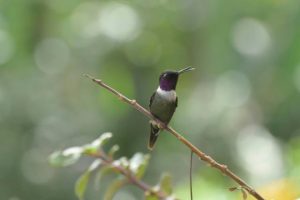
New research is looking into ways artificial intelligence can track animal life in recovering habitats. While it is relatively simple to measure reforestation through surveys with satellite and lidar, it is not so simple to determine how much and how fast wildlife is returning to an area. Sometimes, it may require an expert to go through numerous sound recordings to pick out animal calls.
Jorg Muller, field ornithologist and professor at the University of Wurzburg Biocenter, made an attempt to find a different way. ‘I saw the gap that we need, particularly in the tropics, better methods to quantify the huge diversity… to improve conservation actions,’ he told AFP.
Muller turned to bioacoustics, a long-standing research tool which uses sounds to acquire more knowledge about animal habitats and life. Paired with computer learning, bioacoustics can process large amounts of data much faster.
Muller and his team recorded sounds at sites in Ecuador’s Choco region including recently abandoned cacao plantations and pastures, old-growth forests, and agricultural land recovering from use. The team had experts listen to the recordings and pick out various amphibians, birds, and mammals.
Next, they executed an acoustic index analysis, which provides a measure of biodiversity based on broad metrics from a soundscape like frequency and volume of noises. The two weeks of recordings was ran through an AI-assisted computer programme that was trained to identify 75 different bird calls.
To check if the programme was able to correctly identify the relative biodiversity of each location, the team used one baseline from the experts who listened to the recordings, and another based on insect samples from each location.
Although the AI model had only a small amount of available sounds from which it identified a quarter of the bird calls, it still correctly measured the biodiversity levels in each location.
‘Our results show that soundscape analysis is a powerful tool to monitor the recovery of faunal communities in hyperdiverse tropical forest,’ said the study. It was published in the Nature Communications journal.
‘Soundscape diversity can be quantified in a cost-effective and robust way across the full gradient from active agriculture to recovering and old-growth forests,’ it added.
However, the research still faces some shortcomings. For example, there is a scarcity of animal sounds to train the AI models with, and the approach can only capture species that announce their presence with sound.
‘Of course there is no information on plants or silent animals. However, birds and amphibians are very sensitive to ecological integrity, they are a very good surrogate,’ Muller said.
Given the current push for ‘biodiversity credits’, Muller is confident that the tool could become useful.
‘Being able to directly quantify biodiversity, rather relying on proxies such as growing trees, encourages and allows external assessment of conservation actions, and promotes transparency,’ the study said.
By Marvellous Iwendi.
Source: Yahoo News